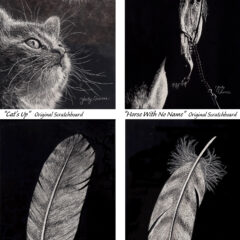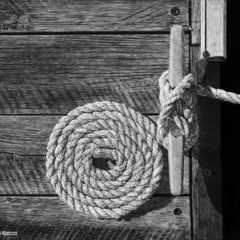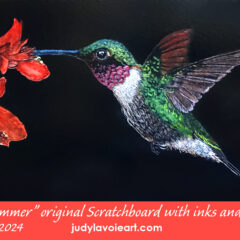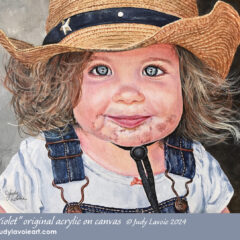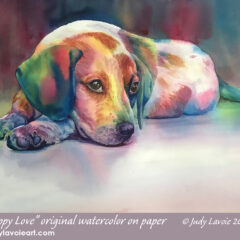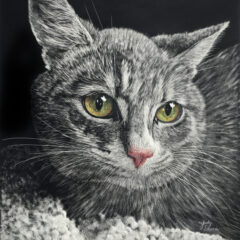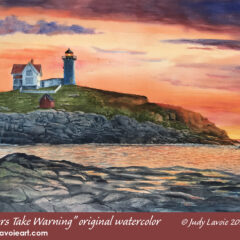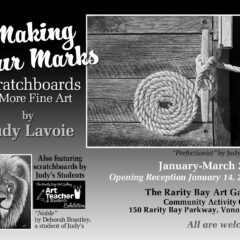 |
| “Elle’s Tobacco Planter” |
I once visited a gallery where the artist’s bio said he painted everything from his imagination – this was hard to believe, considering his work was realistic, detailed, and covering a wide variety of subjects.
I learned quickly when I began painting decades ago that I would need to rely on reference photos to paint from. Some artists work outdoors, on location – en plein air – but that requires the time and flexibility to get out with all your equipment at a designated time. Since painting is my ‘moonlighting job’ that kind of scheduling doesn’t work. And my brain doesn’t function like that gallery artist’s; to paint the way I most enjoy, representationally and with detail, I need to have reference photos. I often do commissioned paintings of pets, homes, and other personal themes, and good reference photos are essential to help me capture exactly what my customer wants.
The photos shown at the top of this post were among many I took of an old piece of farm equipment, parked along my friend Mitch’s long driveway. I photographed in different seasons, at different times of the day, and from different angles, which all helped me to paint “Elle’s Tobacco Planter.”
 |
| “Jerry Van, Music Man” |
For years I’ve been using the same point-and-shoot 14.1 megapixel digital camera, after a long reluctance to retire my 35mm film camera. Mine is a Sony Cybershot with a Carl Zeiss 4x zoom lens. Even smart phones take great photos these days, with amazing ability to capture low-light scenes without using a flash. My camera is small and easy to carry, so I often slip it into my purse just in case that inspiring scene reveals itself when unexpected. Many photos I’ve taken were not with the intension of using for a painting, but later inspired me. I have a huge digital file of potential images for future paintings, and I call upon it frequently. Many people say my artwork looks like a photo, but I am only trying to use my photos as references, changing the colors, lighting, composition, emphasis, arrangements, and other aspects to suit my art. Notice the many different angles I shot photos of the two outdoor musicians; one eventually became the basis for my painting “Jerry Van, The Music Man.”
With so many images readily available online, most art competitions and galleries are now requiring that any paintings submitted are not based photos taken by anyone other than the artist. Now, more than ever, it is important for a painter to take his/her own reference photos.
The following tips are helpful in using photos as reference for paintings, but they are also good basic photography tips, even for non-artists.
- Take lots of photos, but trash any which are out of focus, do not show the subject well, have bad lighting, or for any reason are simply not good.
- Take photos in high resolution. Low resolution is fine for internet use, but high resolution will retain all the detail when enlarged or printed.
- Hold your camera square with the subject in front of you; if you tilt the camera down, as you might if photographing a flower, or you turn it up, as you might if photographing a tall building, then the image’s perspective will be distorted. A camera lens doesn’t see exactly as the human eye does.
- Try to be a eye-level with your ‘center of interest.’ This might mean laying on the ground to capture a basket of napping kittens or standing at a second story window to photograph a statue.
- Move around in front of your scene; a slightly different angle might reveal it in a more interesting manner. A lovely side-lit shot might turn stunning when the same subject is backlit, as happened with my reference photos for my painting “When She Was Three.”
- Take wide and close-up shots; wide shots give you more flexibility for cropping off some of the edges, and close-up shots show more detail.
- Learn to use the exposure settings on your camera; if I photograph a blue flower in normal mode, the blue tends to turn white. By adjusting the “OEV” setting, I compensate for the camera’s default setting. I try shots at various settings on the ± OEV scale. This changes the exposure value and I am able to capture the blue properly.
- When possible, take photos of your subject in different lighting, at different times of the day, or in differing weather conditions. See how I returned to photograph the old truck in “Volunteers” in different lighting.
- When photographing animals or people, it’s helpful to use a ‘burst’ setting, On my camera, this setting takes 3 photos at 0.7 second intervals with one touch of the shutter button. This helps with blinking or moving subjects.
- Take both horizontal and vertical shots
- You can use ‘artistic license’ anytime, altering your photo, adding or deleting to the image. You can combine references from several photos into one painting, as you’ve often seen me do. See how I did this in my recent painting “Red Bug.”
- Repeat Step 1!
As the reference photos with the old barn show, I took photos from different points of view. For my painting “Jesus Saves,” I chose to crop the image as shown with the green rectangle, and added the handlettering as a focal point in my painting.
 |
| “Jesus Saves” |
For specifically taking photos of pets, read more of my photography tips on this page of my website.



